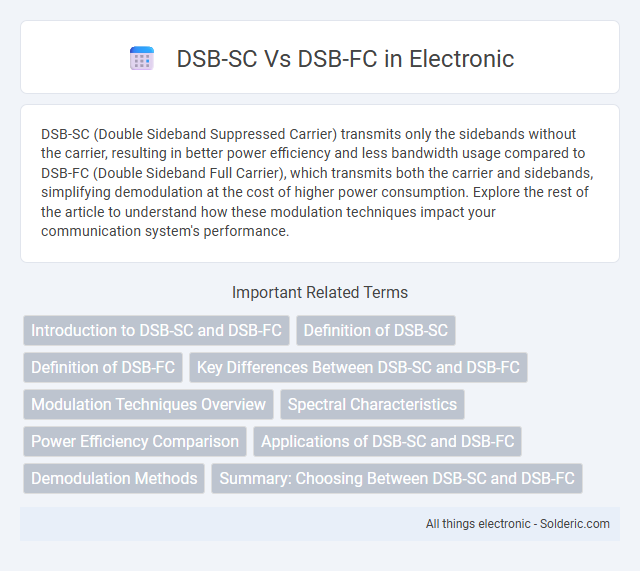DSB-SC (Double Sideband Suppressed Carrier) transmits only the sidebands without the carrier, resulting in better power efficiency and less bandwidth usage compared to DSB-FC (Double Sideband Full Carrier), which transmits both the carrier and sidebands, simplifying demodulation at the cost of higher power consumption. Explore the rest of the article to understand how these modulation techniques impact your communication system's performance.
Comparison Table
| Feature | DSB-SC (Double Sideband Suppressed Carrier) | DSB-FC (Double Sideband Full Carrier) |
|---|---|---|
| Carrier Transmission | Carrier is suppressed (not transmitted) | Carrier is fully transmitted |
| Power Efficiency | More power-efficient (power used only in sidebands) | Less power-efficient (power wasted in carrier) |
| Bandwidth | Twice the message signal bandwidth | Same as DSB-SC, twice the message bandwidth |
| Detection Method | Coherent detection required (synchronized carrier) | Envelope detection possible (simple demodulation) |
| Complexity | More complex receiver due to coherent detection | Simple receiver design |
| Transmission Range | Lower due to no carrier power | Higher due to transmitted carrier power |
| Use Cases | Used where power efficiency is critical | Used in commercial AM radio broadcasting |
Introduction to DSB-SC and DSB-FC
DSB-SC (Double Sideband Suppressed Carrier) modulation transmits signals by suppressing the carrier frequency, enhancing power efficiency and reducing bandwidth usage compared to traditional methods. DSB-FC (Double Sideband Full Carrier) retains the carrier frequency, simplifying demodulation but requiring higher power due to carrier transmission. Understanding these differences helps you optimize communication system performance based on power and bandwidth constraints.
Definition of DSB-SC
DSB-SC (Double Sideband Suppressed Carrier) is a modulation technique where the carrier signal is suppressed, allowing only the sidebands containing the information to be transmitted, which improves power efficiency compared to DSB-FC (Double Sideband Full Carrier). In contrast, DSB-FC transmits both the carrier and sidebands, making it simpler but less power-efficient. Understanding DSB-SC helps you optimize communication systems by reducing bandwidth usage and enhancing signal clarity.
Definition of DSB-FC
DSB-FC (Double Sideband Full Carrier) is an amplitude modulation technique where the carrier signal is transmitted along with both upper and lower sidebands, ensuring the carrier remains at full strength. DSB-SC (Double Sideband Suppressed Carrier) differs by suppressing the carrier, transmitting only the sidebands, which improves power efficiency but requires more complex demodulation at the receiver. Your choice between DSB-FC and DSB-SC depends on the balance between system simplicity and power efficiency requirements.
Key Differences Between DSB-SC and DSB-FC
DSB-SC (Double Sideband Suppressed Carrier) transmits only the sidebands without the carrier, which improves power efficiency and reduces bandwidth usage compared to DSB-FC (Double Sideband Full Carrier) that transmits both sidebands and the carrier. The absence of the carrier in DSB-SC demands coherent detection for demodulation, whereas DSB-FC can utilize simpler envelope detectors due to the presence of the carrier signal. DSB-SC offers better signal-to-noise ratio and power utilization, making it more suitable for bandwidth-efficient and power-sensitive communication systems.
Modulation Techniques Overview
DSB-SC (Double Sideband Suppressed Carrier) modulation transmits information by suppressing the carrier signal, resulting in reduced power consumption and improved bandwidth efficiency compared to DSB-FC (Double Sideband Full Carrier), which transmits the carrier along with both sidebands. DSB-FC modulation simplifies demodulation using envelope detectors since the carrier is present, but it requires more power and bandwidth. The choice between DSB-SC and DSB-FC impacts system design considerations such as transmitter complexity, power efficiency, and receiver architecture.
Spectral Characteristics
DSB-SC (Double Sideband Suppressed Carrier) exhibits a spectral profile where the carrier frequency is removed, resulting in two symmetrical sidebands around the carrier frequency, effectively halving the transmitted power. DSB-FC (Double Sideband Full Carrier) includes both sidebands and the carrier frequency itself, leading to increased bandwidth and power consumption due to the presence of the unmodulated carrier component. The absence of the carrier in DSB-SC minimizes spectral waste and improves power efficiency, making it preferable in bandwidth-sensitive communication systems.
Power Efficiency Comparison
DSB-SC (Double Sideband Suppressed Carrier) demonstrates higher power efficiency compared to DSB-FC (Double Sideband Full Carrier) because it transmits only the sidebands without the carrier component, leading to significant power savings. In DSB-FC, the carrier consumes a large portion of the total transmitted power without carrying information, reducing overall efficiency. As a result, DSB-SC optimizes power usage by focusing energy solely on the informative sidebands, making it more suitable for power-sensitive communication systems.
Applications of DSB-SC and DSB-FC
DSB-SC (Double Sideband Suppressed Carrier) modulation is widely used in applications requiring efficient power usage and better noise performance, such as in analog communication systems for amplitude modulation in point-to-point radio communications and single sideband transmission systems. DSB-FC (Double Sideband Full Carrier) modulation finds applications in standard AM broadcasting, where the presence of a full carrier allows simpler receiver designs and compatibility with conventional AM radios. Both techniques serve different purposes: DSB-SC is preferred in bandwidth-efficient and power-sensitive communications, while DSB-FC is common in commercial AM radio broadcasting due to its ease of demodulation.
Demodulation Methods
DSB-SC (Double Sideband Suppressed Carrier) demodulation typically employs synchronous detection, requiring the receiver to generate a carrier signal precisely synchronized with the transmitter's carrier frequency and phase, ensuring accurate recovery of the original baseband signal. In contrast, DSB-FC (Double Sideband Full Carrier) allows simpler envelope detection due to the presence of the carrier, enabling demodulation without carrier synchronization but at the cost of higher power consumption and reduced efficiency. Your choice between these methods depends on the trade-off between demodulation complexity and system performance requirements.
Summary: Choosing Between DSB-SC and DSB-FC
DSB-SC (Double Sideband Suppressed Carrier) offers higher power efficiency by eliminating the carrier signal, making it ideal for applications prioritizing bandwidth and power savings. In contrast, DSB-FC (Double Sideband Full Carrier) provides simpler demodulation and better signal robustness, suitable for systems where carrier recovery is critical. Your choice depends on balancing power efficiency with demodulation complexity and system requirements.
DSB-SC vs DSB-FC Infographic

 solderic.com
solderic.com